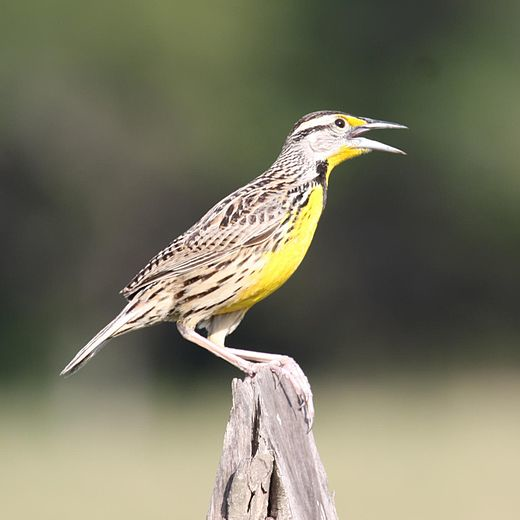
Caption
An eastern meadowlark (Sturnella magna) stands on a fence post. The bird’s population is on the decline.
Credit: Wikipedia Commons

An eastern meadowlark (Sturnella magna) stands on a fence post. The bird’s population is on the decline.
Georgia conservationists are calling on a flock of lame ducks to help protect the state’s wildlife.
The Recovering America’s Wildlife Act calls for dedicating $1.3 billion annually for state fish and wildlife agencies to help restore and protect threatened wild lands and creatures. If it becomes law, Georgia is set to get $27.4 million of those funds.
In 2022, Georgia’s Department of Natural Resources received about $1.5 million in State and Tribal Wildlife Grants to protect the state’s 640 at-risk species and habitats.
“That’s not a lot of money, when you think about what it costs to pay one person with their benefits,” said Brett Albanese, deputy chief of wildlife conservation at the Georgia Department of Natural Resources. “We have about over 70 full-time staff. We have to apply for so many extra competitive grants, and it puts a burden on us to manage all of those. RAWA, we would get this big chunk, and we could spend more time doing the conservation projects and less time shuffling grant paperwork.”
The measure passed the House 231-190 in June on mostly party lines. All of Georgia’s Democratic members voted in favor, and no Georgia Republicans were among the 16 GOP members who supported the measure. It awaits a vote in the Senate, but with the days on the calendar dwindling, time for the vote is running short.
“This is the time to make this work,” said Mike Worley, CEO of the Georgia Wildlife Federation. “We are in the lame duck of Congress. This bill has to start over again if we don’t finish it in the next couple of weeks. And so we have just a few working days left to go in Congress, and we really need to pass this.”
Georgia ranks No. 6 among states for biological diversity, but many of its wild inhabitants are struggling with man-made problems like habitat loss.
“I like to think of something like the eastern meadowlark,” Worley said. “We all have seen them. Most of us grew up seeing them every day of our lives. Their population is down 71%. In the last 40 years.”
Both of Georgia’s senators are co-sponsors of the bill. Worley said he is hoping the Senate will approve the funding as part of its year-end omnibus bill.
“It’s been a concern for some of our legislators about coming up with a pay-for for this initiative,” he said. “We have come up with a model to pay for it that has been approved, it meets all the standards. So we met that standard, so it will have to be included. It is a standalone bill, it can pass that way, but the likelihood is almost zero just given the short timeframe of Congress left.”
The funding mechanism involves changing the tax treatment of cryptocurrency, Worley said.
According to an E&E News report, the Senate Finance Committee has discussed raising funds by closing a tax loophole that allowed people to claim a loss on cryptocurrency sold at a loss and then reacquired within 30 days. The rule change would raise either $11.2 billion or $12.5 billion over 10 years, according to the report.
Jennifer Mickelberg, vice president of collections and conservation at Zoo Atlanta, said she’s hoping the Senate will succeed in putting that money aside for threatened Georgia critters before time runs out.
“I think the sad truth is what we’re trying to do is reduce the decline,” she said. “We’re probably as good today as we’re gonna get, so what we really want to do is to try to make sure we’re trying to minimize the decline of wildlife.”
This story comes to GPB through a reporting partnership with Georgia Recorder.